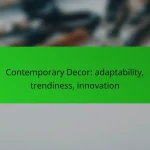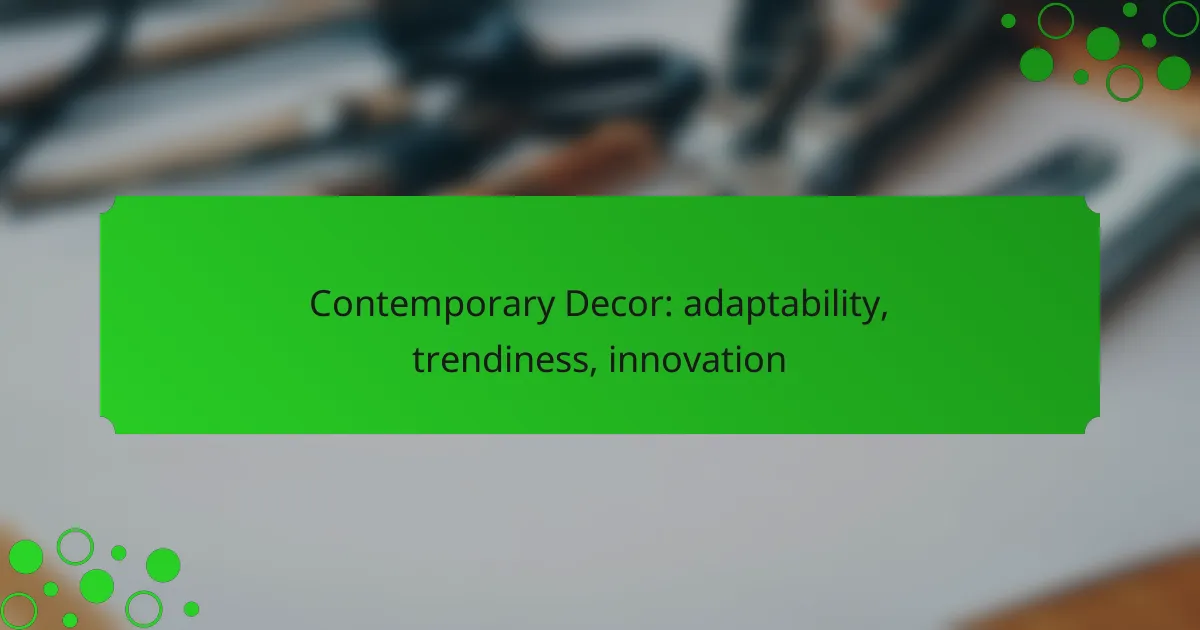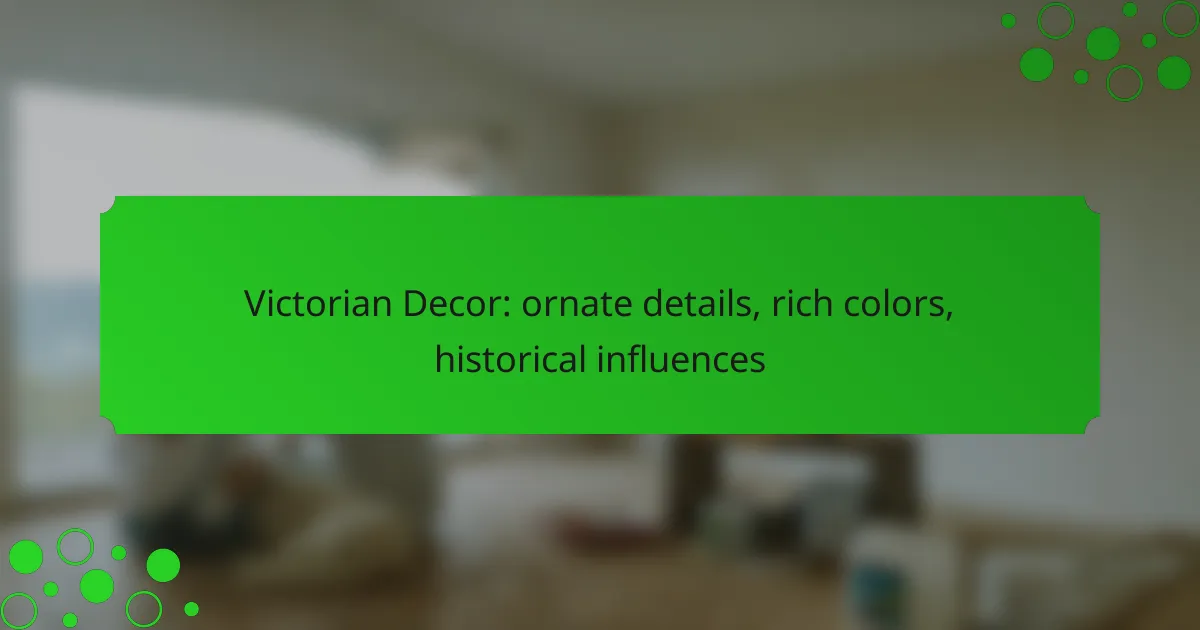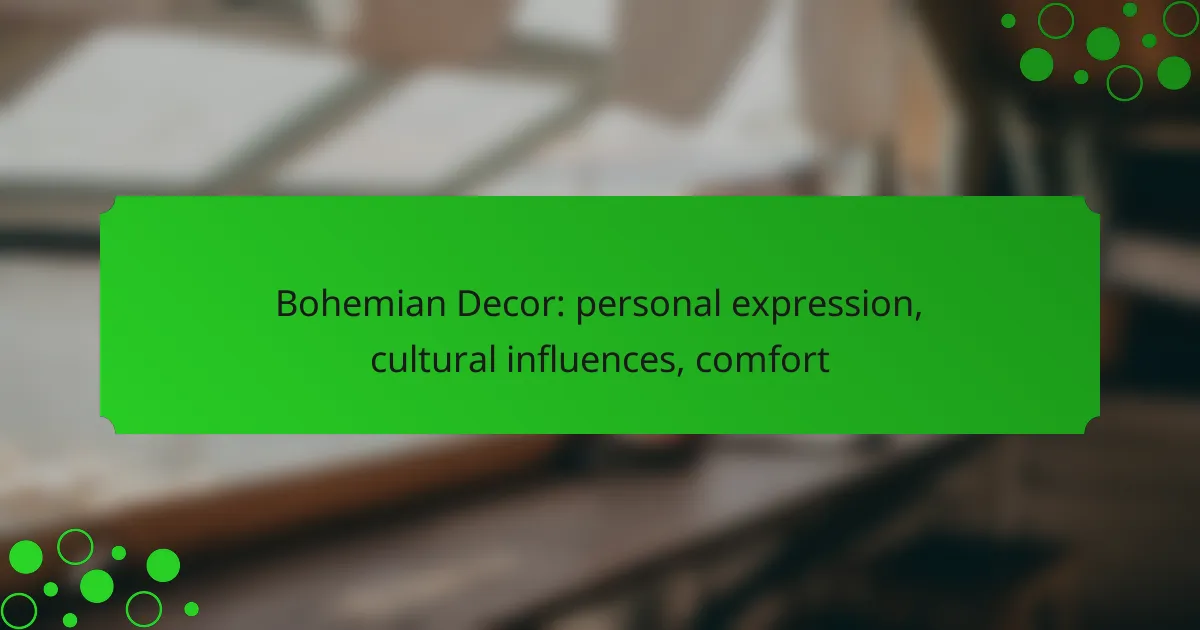Contemporary decor embodies a dynamic blend of adaptability, trendiness, and innovation, making it ideal for modern living spaces. By prioritizing versatile designs and smart solutions, homeowners can create environments that are both stylish and functional. Embracing trends like biophilic design and minimalist aesthetics allows for a seamless integration of comfort and technology, ensuring spaces remain relevant and inviting.
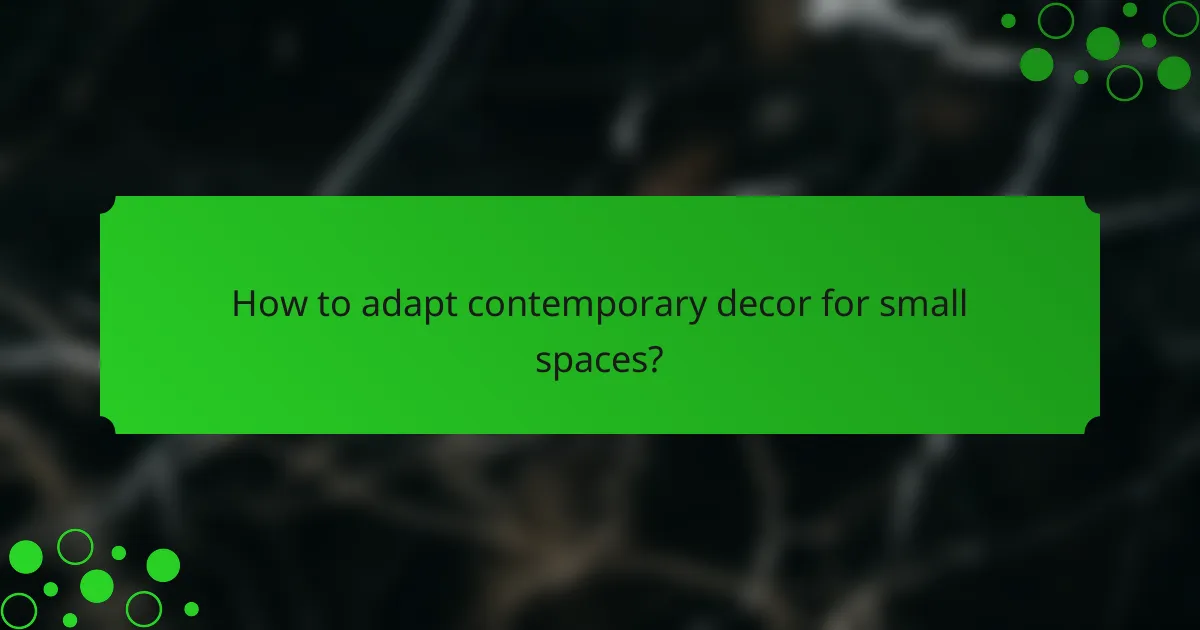
How to adapt contemporary decor for small spaces?
Adapting contemporary decor for small spaces involves maximizing functionality while maintaining a stylish aesthetic. Focus on using versatile pieces, light colors, and smart storage solutions to create an open and inviting atmosphere.
Multi-functional furniture
Multi-functional furniture is essential for small spaces, as it serves more than one purpose. For example, a sofa bed can transform a living area into a guest room, while an ottoman with storage can double as a coffee table and a place to store blankets.
When selecting multi-functional pieces, consider items that are easy to move and versatile in design. Look for furniture that can be easily reconfigured or adapted to different needs, such as a dining table that expands for guests.
Light color palettes
Using light color palettes can significantly enhance the perception of space in smaller areas. Soft hues like whites, pastels, and light grays reflect more light, making a room feel larger and more open.
Incorporate light colors in walls, furniture, and decor to create a cohesive look. You can add pops of color through accessories like cushions or artwork, which can be easily changed without overwhelming the space.
Vertical storage solutions
Vertical storage solutions are crucial for maximizing space in small areas. Shelving units that extend to the ceiling can provide ample storage without taking up valuable floor space, allowing for better organization and display of items.
Consider wall-mounted shelves, tall bookcases, or hanging organizers to keep the floor clear. Utilize the vertical space effectively by placing frequently used items at eye level and less-used items higher up.
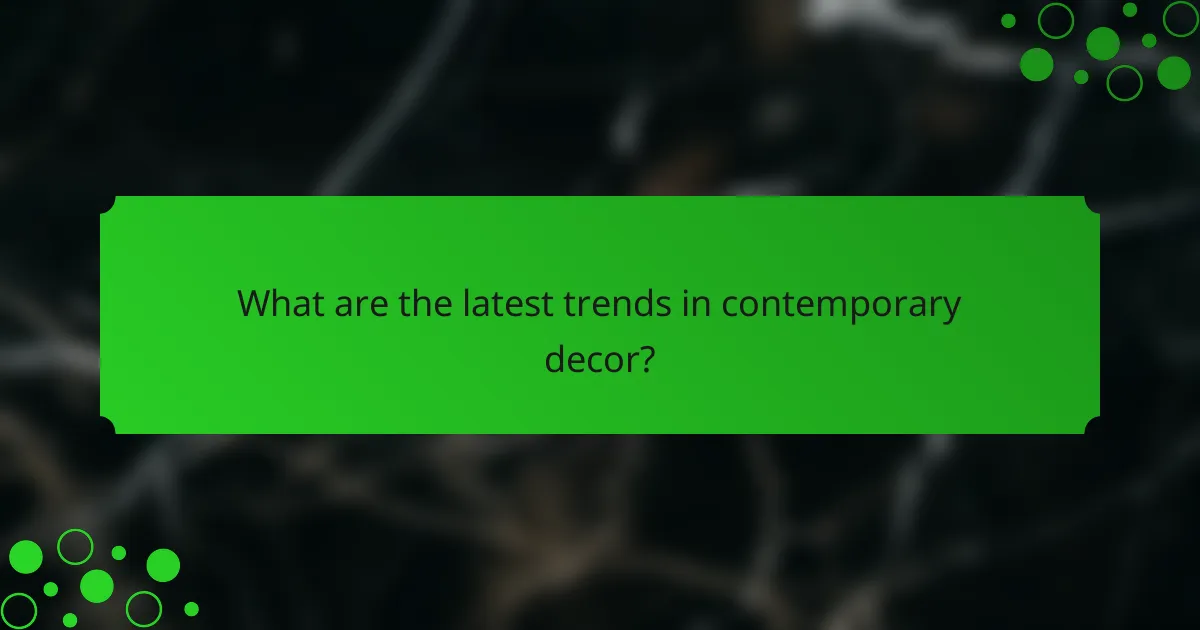
What are the latest trends in contemporary decor?
The latest trends in contemporary decor focus on adaptability, trendiness, and innovation, emphasizing designs that enhance well-being, simplicity, and technology integration. Key trends include biophilic design, minimalist aesthetics, and smart home integration, each offering unique benefits and considerations for modern living spaces.
Biophilic design
Biophilic design incorporates natural elements into interior spaces to create a connection with nature. This trend can include features like indoor plants, natural light, and organic materials, which promote well-being and reduce stress. Consider using large windows, green walls, or water features to enhance this connection.
When implementing biophilic design, aim for a balance between indoor and outdoor elements. For instance, using wood finishes and stone accents can evoke a natural feel while maintaining a contemporary look. Be mindful of maintenance; choose plants that thrive indoors and require minimal care.
Minimalist aesthetics
Minimalist aesthetics prioritize simplicity and functionality, focusing on clean lines and uncluttered spaces. This trend encourages the use of a limited color palette and essential furnishings, creating a serene environment. To achieve a minimalist look, select versatile furniture that serves multiple purposes and avoid excessive decor.
Consider adopting a “less is more” philosophy by decluttering your space and keeping only items that serve a purpose or bring joy. Use storage solutions that blend seamlessly with your decor to maintain an open and airy feel. Remember, minimalism is about quality over quantity, so invest in high-quality pieces.
Smart home integration
Smart home integration involves incorporating technology into decor to enhance convenience and efficiency. This trend includes smart lighting, thermostats, and security systems that can be controlled remotely. When designing your space, consider how technology can improve your daily routines and overall comfort.
To effectively integrate smart home features, choose devices that are compatible with each other and easy to use. For example, smart lighting can be programmed to adjust automatically based on the time of day, enhancing both functionality and ambiance. Be cautious of overcomplicating your setup; aim for a streamlined approach that complements your decor rather than detracts from it.

How to choose contemporary decor for a modern home?
Choosing contemporary decor for a modern home involves focusing on simplicity, functionality, and a blend of innovative design elements. Prioritize pieces that reflect current trends while ensuring they can adapt to changing styles over time.
Focus on clean lines
Clean lines are a hallmark of contemporary decor, emphasizing minimalism and simplicity. Look for furniture and accessories that feature straight edges and geometric shapes, which create a sense of openness and clarity in your space.
When selecting items, consider how they interact with your home’s architecture. For instance, a sleek sofa with a low profile can enhance a room’s spaciousness, while angular coffee tables can serve as striking focal points.
Incorporate bold accents
Bold accents can add personality and vibrancy to contemporary decor. Use bright colors, unique patterns, or standout art pieces to create visual interest against a neutral backdrop.
Consider integrating a single statement piece, such as a large abstract painting or a brightly colored chair, to draw attention and spark conversation. This approach allows you to maintain a modern aesthetic while showcasing your personal style.
Consider sustainable materials
Sustainable materials are increasingly important in contemporary decor, reflecting a growing awareness of environmental impact. Opt for furniture made from reclaimed wood, recycled metals, or eco-friendly fabrics to enhance both style and sustainability.
When shopping, look for certifications like FSC (Forest Stewardship Council) for wood products or organic labels for textiles. These choices not only contribute to a healthier planet but can also add unique character to your home.

What are the benefits of contemporary decor?
Contemporary decor offers numerous advantages, including adaptability to various styles, trendiness that keeps spaces feeling fresh, and innovative design elements that enhance living environments. These benefits make it a popular choice for homeowners and designers alike.
Enhanced functionality
Contemporary decor emphasizes practicality, ensuring that spaces are not only visually appealing but also functional. This can include multi-purpose furniture, open floor plans, and smart storage solutions that maximize space efficiency.
For example, a contemporary living room might feature a sleek sofa that converts into a bed, allowing for both relaxation and accommodation of guests. When selecting contemporary pieces, consider how each item can serve multiple roles in your home.
Timeless appeal
While contemporary decor is often associated with current trends, it also possesses a timeless quality that can withstand changing fashions. Clean lines, neutral color palettes, and natural materials contribute to a look that remains stylish over time.
Incorporating classic elements, such as a well-designed armchair or a statement piece of art, can enhance the enduring appeal of your space. Aim for a balance between trendy and timeless to create a lasting aesthetic.
Increased property value
Investing in contemporary decor can significantly boost your property’s market value. Homes that showcase modern design elements often attract buyers looking for updated features and aesthetics.
To maximize this benefit, focus on high-quality materials and finishes that appeal to potential buyers. Simple upgrades, like installing contemporary lighting fixtures or updating kitchen cabinetry, can yield a strong return on investment when selling your home.

How to mix contemporary decor with traditional styles?
Mixing contemporary decor with traditional styles involves blending modern aesthetics with classic elements to create a cohesive look. Focus on balancing different design philosophies while ensuring that the overall space feels harmonious and inviting.
Balance contrasting elements
To effectively balance contrasting elements, select a few key pieces from each style that complement rather than clash. For instance, pair a sleek, modern sofa with a vintage coffee table to create visual interest. Aim for a mix of materials and shapes that enhance the overall design without overwhelming the space.
Consider using a neutral color palette as a foundation, then introduce pops of color or pattern through accessories. This approach allows for a seamless integration of contemporary and traditional elements while maintaining a unified aesthetic.
Use transitional furniture
Transitional furniture acts as a bridge between contemporary and traditional styles, making it easier to create a balanced decor. Look for pieces that feature clean lines but incorporate traditional materials, such as a modern chair upholstered in a classic fabric. This helps to soften the starkness of contemporary designs.
When selecting transitional furniture, prioritize versatility. Choose items that can adapt to different settings or styles, allowing for easy updates as trends evolve. This adaptability ensures that your decor remains fresh and relevant over time.
Layer textures
Layering textures is essential for achieving depth and warmth in a space that combines contemporary and traditional decor. Use a variety of materials, such as smooth metals, soft fabrics, and rustic woods, to create a rich tactile experience. For example, a plush area rug can soften a sleek hardwood floor while adding comfort.
Incorporate different textures through cushions, throws, and wall art. This not only enhances visual interest but also invites a sense of coziness. Be mindful of balancing heavier textures with lighter ones to maintain an airy feel in the room.

What are the key attributes of contemporary decor?
Contemporary decor is characterized by its adaptability, trendiness, and focus on innovation. It emphasizes clean lines, functional spaces, and a harmonious blend of aesthetics and practicality.
Flexibility in design
Flexibility is a cornerstone of contemporary decor, allowing spaces to evolve with changing needs and preferences. This can be achieved through modular furniture, adjustable lighting, and multi-functional rooms that serve various purposes.
For instance, a living room can easily transform into a workspace by incorporating foldable desks or movable partitions. Consider using furniture that can be reconfigured or easily stored to maximize space efficiency.
Emphasis on innovation
Innovation in contemporary decor often involves the use of new materials and technologies that enhance functionality and sustainability. This includes eco-friendly products, smart home devices, and cutting-edge design techniques that push traditional boundaries.
For example, incorporating energy-efficient lighting and sustainable materials not only reduces environmental impact but also aligns with modern aesthetic trends. Stay updated on emerging design technologies to keep your space fresh and relevant.
Focus on aesthetics
Aesthetics in contemporary decor prioritize simplicity and elegance, often featuring neutral color palettes accented with bold elements. This approach creates a visually appealing environment that feels both inviting and sophisticated.
To achieve this, consider using a mix of textures and materials, such as wood, metal, and glass, to add depth to your decor. Balance is key; ensure that decorative elements complement each other without overwhelming the space.





